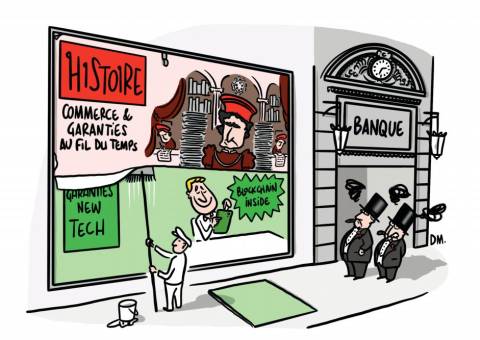How have pension funds’ allocations evolved since the financial crisis?
It has been a challenge to gather information about pension funds around the world, but we succeeded in collecting a sizable sample. A global phenomenon soon appeared: there has been a dramatic increase of their alternative assets allocations over the past 10 years, which is consistent with the global environment of low interest rates.
Through our sample, we observed an additional $1.8 trillion shift to alternatives by pension funds between 2008 and 2017. All continents are concerned, all countries, even though they present very different profiles, like Brazil, France, or South Africa. On average, in developed markets, pension funds increased their share of alternative assets under management from 7.2% to 11.8% from 2008 to 2017, a 63 % increase. In the same time, the share went from 0.97% to 6.6% for pension funds in emerging markets.
This expansion shows us for both private and public funds, and pension funds of all sizes. The increase is economically and statistically significant.
Is there a mechanical explanation or is it the result of a strategic change?
If the explanation were mechanical, it would mean that the relative share of alternative assets increased because other asset classes underperformed or were sold as a result of overall assets contraction. But what we observe is a general growth of pensions assets (higher than its historic average), and other asset classes doing quite well.
Shift to alternative assets classes appears to be a broad strategic move. Our study shows that currency areas with lower interest rates environments had the largest increase in allocations to alternatives. Structural factors specific to the various countries are also at stake. For instance, in the United States, low interest rates combined with the fact that state pension funds are largely underfunded explain the search for better returns, and thus for alternative assets.
Do you observe a currency bias in the alternative investments made by pension funds?
We do not observe the currency of investments. But the alternative market is heavily concentrated in the United States, meaning that European funds are significantly investing in the U.S. This is because U.S. country presents several particularities. The public market is larger than in Europe, as a result, it is to buy and easier to exit. The credit markets are also substantially more developed. There is a strong culture of private equity, for all sizes of deals, which is not yet the case even across Europe. It creates a bias towards the U.S. and dollar activities. Add to that the fact that, within pension funds, private equity portfolios are not widely diversified, but tend to be concentrated on a couple of bets.
Within the alternative class, what is the allocation between assets?
Private debt is gaining popularity, although private debt is not a large enough market to be the major allocation. With private debt, you can reach about 8% expected return with a lower risk profile, which is in line with pensions investment objectives. Its share should continue to grow in the allocations, depending on restrictions that local regulations can place for investors on that kind of market. That said, private equity and real estate are still the bulk of pension funds’ alternative investments.
Did returns meet the expectations?
What we know, according to indicators, is that, historically, private equity as an asset class outperformed the listed equity market (net of fees). There is some debate about what the proper risk-adjustments of these returns is, but, one way or another, the consensus is that private equity beats the public market. Historically, private debt was very small, so we do not have the hindsight to evaluate its returns.
However, the question of returns raises another issue: how will a massive pensions’ expansion into alternatives impact the future returns for this asset class? Can the industry deliver the same returns when its size essentially doubles in the span of ten years?
How can you assess this risk?
There are many examples of pension funds making mistakes in taking investment decisions. They are not agile institutions and they face many political and governance pressures. With my co-author Josh Lerner, we dedicated a book to the imperfect process of decision making in investment (“Patient capital
It does not mean that alternative investments should not be in pension funds’ portfolios, they do belong pensions’ balance sheet. But the sharp increase of allocations to alternatives points out to governance issues and to the lack of sophistication of many pension funds. It is not an explosive situation and does not pose the threat of a sudden contagion for the market (the way the banks’ investments do), but there is a mounting pressure on alternative assets’ future performances. We should as well take into account the illiquidity of those positions, because it will play a role in case of a sharp correction.
Do you think the shift towards alternative assets will last over time?
The question is not whether pensions should invest in alternatives, but how they should invest in alternatives. Because of their liability structure, pensions are particularly suitable to invest in illiquid, long-term assets. But with the pensions’ aggressive expansion into alternatives pushed by ten years of low interest rates, it is unlikely that the returns will meet expectations. The worst-case scenario I foresee would be, as years go by, to see returns proving not that attractive and resulting in overreaction and shutdown of the alternatives positions. It would be a mistake, and would cause great difficulties for the industry.
We should take this situation as an opportunity to learn our lesson and to encourage pension funds to become more coordinated and professional in their investment decisions.
Regarding private debt, some people disregard it as an arbitrage opportunity that arose as banks faced higher scrutiny in the post-GFC world. But it is more complex, thoughtful, and creative than that. This asset class was born under the pressure of investors, but, in my view, it is here to stay.
-
1 Ivashina V. and Lerner J. (2019), Patient Capital: The Challenges and Promises of Long-Term Investing, Princeton University Press.







